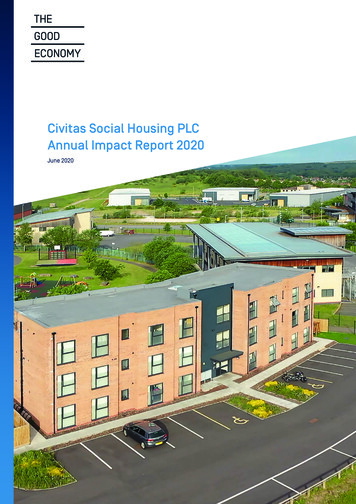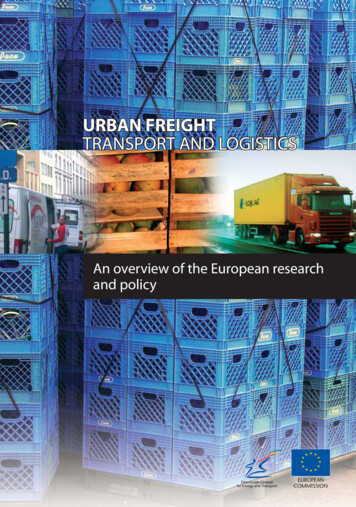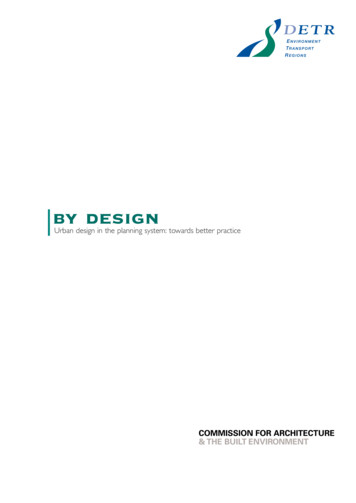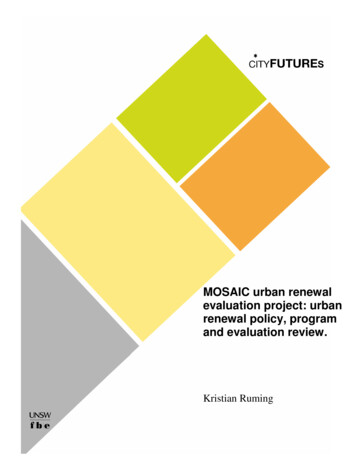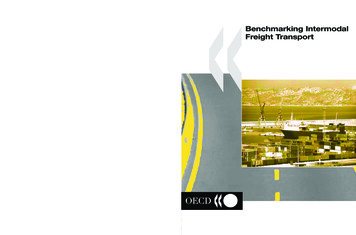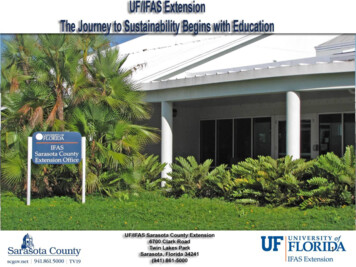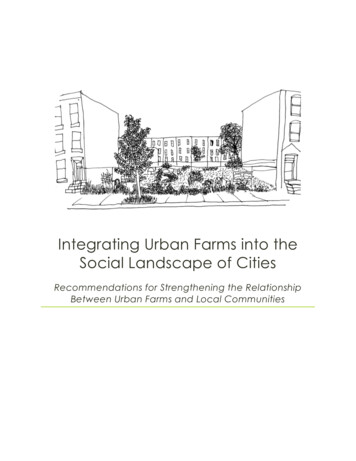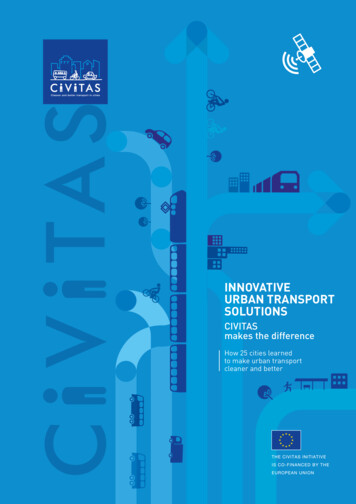
Transcription
INNOVATIVEURBAN TRANSPORTSOLUTIONSCIVITASmakes the differenceHow 25 cities learnedto make urban transportcleaner and better
INNOVATIVEURBAN TRANSPORTSOLUTIONSCIVITASmakes the differenceHow 25 cities learnedto make urban transportcleaner and better
4ImprintAbout VANGUARDLaunched in September 2008, CIVITAS VANGUARDwas a 74-month grant-based project of the EuropeanCommission’s Directorate-General for Mobility andTransport (DG-MOVE), funded as part of the CIVITASInitiative. It was a support action for the coordinationand dissemination of CIVITAS Plus, the third phaseof the CIVITAS Initiative, and as such served theCIVITAS Plus collaborative projects and the CIVITASInitiative itself.Funded under the European Commission’s SeventhFramework Programme for Research andTechnological Development, VANGUARD focused onthe dissemination of research activities, results andexperiences from cities and projects participating inCIVITAS.PublicationThis publication is intended for all those with aninterest in sustainable urban mobility and theCIVITAS Initiative. It is available from the KnowledgeBase on the CIVITAS website: www.civitas.eu.PublisherOn behalf of the CIVITAS Initiative, ICLEI – LocalGovernments for Sustainability, EuropeanSecretariat. Executive Director Wolfgang Teubner.AuthorsFlorinda Boschetti, Isabelle Maurizi, Ivo Cré (Polis)EditorCiara Leonard (ICLEI Europe)Copy editorRachel Hideg (Regional Environmental Center)LayoutStephan Köhler (ICLEI Europe)Legal NoticeThe views expressed in this publication are the soleresponsibility of the authors named and do notnecessarily reflect the views of the EuropeanCommission or the support action VANGUARD.CopyrightAll images in this publication are copyright of theCIVITAS Initiative unless otherwise indicated. Thecontent of this publication may be replicated andbuilt upon. It must, however, be attributed to theCIVITAS Initiative.October 2014
table of contents56About this publication71 Collective passenger transport 81.1 A closer look81.2 The EU context81.3 Challenges faced91.4 Lessons learned101.5 Moving forward101.6 Results/impacts111.7 Recommendations1222.12.22.32.42.52.62.7Safety and securityA closer lookThe EU contextChallenges facedLessons learnedMoving 6163 Car-independent lifestyles3.1 A closer look3.2 The EU context3.3 Challenges faced3.4 Lessons learned3.5 Moving forward3.6 Results/impacts3.7 4.7Urban freight logisticsA closer lookThe EU contextChallenges facedLessons learnedMoving 6275 Clean fuels and vehicles5.1 A closer look5.2 The EU context5.3 Challenges faced5.4 Lessons learned5.5 Moving forward5.6 Results/impacts5.7 Recommendations28282829293030326 Demand management strategies6.1 A closer look6.2 The EU context6.3 Challenges faced6.4 Lessons learned6.5 Moving forward6.6 Results/impacts6.7 Recommendations33333434353536377 Mobility management7.1 A closer look7.2 The EU context7.3 Challenges faced7.4 Lessons learned7.5 Moving forward7.6 Results/impacts7.7 8.7Transport telematicsA closer lookThe EU contextChallenges facedLessons learnedMoving 6469Behavioural change andmobility campaignsWhat is behind behavioural change?Ingredients for real changeUnderstanding behaviourDesigning successful interventionsMeasuring the resultsFinal thoughts on change484848495052529.19.29.39.49.59.610 rther Reading60INNOVATIVE URBAN TRANSPORT SOLUTIONSForeword
6ForewordMoving people and goods in European cities is acontinuous challenge. Energy use, space use, roadsafety, air quality and noise pollution are a few of theroad transport–related issues that European citieshave to cope with. But there is more: local decisionmakers are concerned about equal and affordableaccess to mobility. Every day, our mayors andcouncillors are concerned about finding solutions tourban transport problems that do not slow down thelocal economy but bring local communities toprosperity.Europe might be on the verge of a paradigm shift infinding a solution to this problem: integratedplanning, smart solutions, clean (electric?) vehicles,better public transport, the uptake of soft modes,and restraints on motorised travel were needed Step by step, European cities are establishing aEuropean model for urban transport solutions.The CIVITAS Initiative has proven to be a valuableinstrument to help cities experiment with innovativeurban transport solutions. And with the experimentcome the lessons learned, thanks to a coherentapproach to monitoring and evaluation withinCIVITAS.In the CIVITAS Plus phase of the Initiative, 25 citiescooperated to plan, implement and understand theimpacts of innovative urban transport measures.It has been an interesting time, working against abackdrop of EU, national and local policies to tacklethe economic crisis. It was also a time when the EUprepared decisive policy documents in the field oftransport (the White Paper on transport), and urbantransport in particular (the Urban Mobility ActionPlan). The experiences described in this publicationhelped to shape these documents.On behalf of the CIVITAS Political AdvisoryCommittee, I invite you to be inspired by theinnovative transport solutions that have been trialledin CIVITAS Plus.Sandor NagyChair of the CIVITAS Political Advisory Committee
About this publicationDuring CIVITAS Plus, over 300 measures wereimplemented in 25 cities over a period of four years.These have contributed to improving commontransport planning practices, shaping the urbanenvironment and changing the way Europeans movearound in cities towards more sustainable, healthyand active living.This publication, together with the other CIVITASPlus outputs (the CIVITAS Measure Directory, LivingLaboratories, Policy Recommendations and CIVITASin Numbers1), aims to inspire transport practitioners,city officials, environment and energy officials,transport and energy managers, town planners,transport planners, municipal leaders and localpoliticians to make bold decisions, set ambitiousgoals and follow sustainable mobility principleswhen designing urban mobility policies.Each chapter covers one of the eight CIVITASthematic categories. These are the building blocksof integrated strategies for changing urban mobilityin European cities and are part of a comprehensiveand integrated approach to transport, as suggestedby sustainable urban mobility planning principles.A set of recommendations, focusing on concreteexamples, is given for each thematic area in order toencourage the take-up of the appropriate measure foreach specific circumstance. Case studies complementeach chapter and offer in-depth information.The closing chapter on changing travel behaviourgives an insight into the shift in personal mobilitypatterns, how professionals have changed the waypeople look at transport measures, and howmembers of the public have learned to adapt to andmake use of new technologies.The information contained in these pages wasgathered from material generated by the fivedemonstration projects under CIVITAS Plus —CIVITAS ARCHIMEDES, CIVITAS ELAN, CIVITASM I M O S A , C I V I TA S M O D E R N a n d C I V I TA SRENAISSANCE. The evaluation reports compiled bythe CIVITAS POINTER Support Action alsocontributed to the analysis. All materials can befound on the CIVITAS website (www.civitas.eu).INNOVATIVE URBAN TRANSPORT SOLUTIONSThe present publication is intended as a criticalreview of the transport measures that weredeveloped and implemented during the CIVITAS Plusphase (2008–2012) of the CIVITAS Initiative. Runningnow for 12 years, the Initiative has helped to changethe face of urban mobility in Europe. It hasestablished a unique mix of innovation, policysupport and public involvement in order to applyintegrated strategies for urban transport. Byimproving mobility in cities, CIVITAS has significantlyimproved the environment, public health and urbanlife as a whole.7
81 Collective passenger transportGood public transport contributes to more accessible,inclusive and liveable cities by improving air quality,optimising road space use and revitalising citycentres. CIVITAS Plus cities put in place innovativemeasures to enhance public transport use.Public transport is a key element of sustainablemobility in cities, and its quality should be maintainedin order to keep existing users and attract new ones.Ways of increasing the attractiveness of publictransport include improving operational efficiency,harmonising tariffs and timetables, and improvingaccessibility and interchange facilities.Within CIVITAS Plus, collective transport measuresaddressed a number of sub-themes: the provision ofreal-time information; the introduction of singletransport passes and integrated multi-modalticketing systems; improved accessibility for peoplewith impaired mobility; improved bus stops and theinstallation of ramp metering systems; theintegration of public transport with cycling, parkand-ride facilities and vertical transport systems;the introduction of security systems; and awarenessraising campaigns on safety.Information systems can improve public transportcapacity and priority as better informationtechnologies become available. New investmentsinclude information infrastructure, and upgraded,more comfortable and more accessible buses.1.1A closer lookCollective passenger transport plays a role in anysustainable urban mobility plan. Cities face thecommon challenge of deploying an integrated,energy-efficient public transport system, with theaim of improving security and safety. High-qualityservices, including enhanced access to informationand adequate ticketing, are essential.Optimised fleet management technology enablesbetter information services, including the provisionof on-board or online route information, SMS orBluetooth dispatching, or electronic informationpanels at public transport stops.Enhanced infrastructure and vehicles can improvepublic transport accessibility. Low-floor minibusesfor people with impaired mobility, as well asmonitoring and communication systems, weredeployed in several CIVITAS Plus cities.Modern ticketing and tariff systems includeintegrated ticketing across different transportsystems, for example through the use of a single(usually contactless) card for payments. Othermeasures focused on the introduction of vendingmachines or ticket sales via Internet or SMS.Improved safety and security for both the generalpublic and public transport users was achievedthrough the installation of surveillance systems onvehicles, in underpasses and at public transportstops. Information and educational materials wereused in campaigns for safe and secure publictransport trips.1.2 The EU contextThe European Commission (EC) estimates thatcongestion costs nearly EUR 100 billion annually, or1 percent of the EU’s GDP2, and the cost is projectedto rise to EUR 200 billion annually if changes are notmade to the mobility system3. The 2011 EC WhitePaper on transport4 suggests that an increasedshare of urban collective transport with enhancedservice obligations would create a virtuous cycle toincentivise public transport use. This would not onlycontribute to the European goal of reducing
To promote the greater use of collective transport,the EC emphasises the need to improve the quality,accessibility and reliability of transport services 5.This requires a mixed strategy involving land-useplanning, pricing schemes, efficient public transportservices and infrastructure, and reliance on cleanervehicles to reduce both congestion and emissions.1.3 Challenges facedThe promotion of collective transport requires avariety of instruments to make it attractive andcompetitive compared to the private car. Theseinstruments include intelligent transport systems(ITS) for smarter ticketing; regulatory and legalmeasures to enhance safety and security; andimproved fleet operations.Encouraging greater use of public transport andenabling a change in people’s travel behaviourrequires a paradigm shift in the way people travel incities. Chapter 9 of the present publication looks indepth at behavioural change techniques andapproaches.Successful smart ticketing implies simple, userfriendly and transparent systems. CIVITAS Plusexamples show that improvements to ticketing andtariff systems face technological challenges. InLjubljana (Slovenia), for example, there were delaysin synchronising the existing ID tickets with the newe-tickets 6. Other technological challenges arisewhen integrating separate information technology(IT) systems into a unified scheme; and developingadequate hardware and software interfaces. Ananalysis of ITS measures can be found in Chapter 8.Safety and security (Chapter 2) have become hottopics in public transport, and local measures in thisarea require coordination among authorities andoperators. Regulatory changes regarding the use ofpersonal data (video recording) are often needed,alongside efforts to boost public acceptance.In terms of fleet management, lack of technologicalknow-how may cause problems, while the lack ofsufficient or adequate co-financing can hamperplans before they are even put into action.Insufficient cooperation between parties can lead todelays in implementation, while complex legislationand administrative procedures may make it difficultto establish the legal foundations for change.9Improving bus services for disabledpeople in Brno, Czech RepublicTo cater for its approximately 50,000 citizenswith impaired mobility, Brno introduced fivespecially adapted minibuses. Customisedpublic transport had previously been neglectedin the city, with standard low-floor buses,designed for only one or two wheelchairs, beingthe only available option. Minimum criteriawere set for each of the new minibuses,according to which each vehicle had to be ableto transport at least six wheelchairs at a time.The vehicles also had to be equipped with amodern information system and loading ramp,and were required to be more environmentallyfriendly than standard buses.Since the launch of the project, the minibuseshave operated on two lines specificallydeveloped for passengers with impairedmobility. The lines cross the city, connecting themain public institutions, hospitals and otherpublic buildings.The minibuses and routes proved highlysuccessful. All five buses were put intooperation and the system met all expectations.In order to further refine the measure, severalmeetings were held with passengers withspecial mobility needs. They expressedsatisfaction with the current status of the bussystem and suggested only minor changes,such as amending the timetable and shiftingthe position of certain bus stops. All thesuggested changes were implemented.According to an analysis carried out by thepublic transport operator, the operating costsof the minibuses are far lower than for standardbuses, thanks to lower fuel consumption andother costs.For more information: ved-bus-servicesdisabledINNOVATIVE URBAN TRANSPORT SOLUTIONSgreenhouse gas (GHG) emissions by 20 percent by2020, but would also directly benefit urban life.
101.4 Lessons learnedThe importance of political commitment, urgencyand drive cannot be overstated, and CIVITAS Plussaw many examples. The city of Funchal (Portugal)was fortunate that its planned collective transportmeasures fitted perfectly with the regionalsustainable development agenda, ensuring politicalsupport from start to finish7. In Monza (Italy), politicalcommitment helped to convince citizens to switch tomore sustainable modes 8, and in Utrecht (theNetherlands) it was political drive that helped topush through measures to improve the quality of buslanes9. In Perugia (Italy), local elections promptedgrowing ambitions for the development of the city’spublic transport infrastructure10.In relation to infrastructure measures, authoritiesshould have a positive attitude towards the plans thatare made. Infrastructure measures requiresubstantial funding, and construction worksometimes causes severe disruptions to traffic.Forward thinking based on a detailed plan, combinedwith a skills development approach, is essentialwhen implementing reliable IT systems. Planningahead and creating opportunities for training andprofessional expertise can help avoid delays inpreparing the system launch and can ensurecompatibility among operators and technologies.S t a k e h o l d e r i n v o lv e m e n t a n d t h e s m a r tcommunication of security measures meansinvolving all affected groups, including those directlytargeted by specific measures.Further legal and regulatory amendments may berequired in order to fully implement safety andsecurity measures.1.5 moving forwardCIVITAS Plus measures for collective passengertransport envisaged improvements to the quality ofservice and ease of use. They also aimed to ensuresafe and secure services. In general, while expectedoutcomes create a positive image, measures mayencounter some resistance if implementation doesnot meet expectations. The lessons mentioned aboveare thus important for the transferability ofmeasures.Investing in infrastructure and networks andimproving accessibility are usually quite costly.Experience gained from implementing measurescan be valuable. Infrastructure improvements areusually well accepted by public transport usersbecause they have a direct impact on comfort andservice quality. However, if the measures requirespatial adjustments, they may not be easy to transfer,as numerous institutional, organisational and financialhurdles will arise. Political support is therefore afurther prerequisite for the success of such measures.Public transport information, ticketing and fleetmanagement measures have transferability potential.The main condition is that the technical equipmentfunctions well, and that systems can be integratedwhere necessary. This requires thorough research,cooperation between stakeholders, and a realisticfinancial plan and time schedule within a stableorganisational structure.Safety and security measures relying on cameratechnology systems are quite transferable. However,they are also affected by local or national legislation,such as laws on privacy in relation to the use ofcameras and data. European legislation must also betaken into account. Safety measures targeting specificgroups (e.g. schoolchildren and elderly or disabledpeople) have great transferability potential.Public transport communication systemin Tallinn, EstoniaCIVITAS supported the installation of a moderncommunication system comprising a drivercommunication unit and an operatorworkstation based on the 3G mobilecommunication standard. The system wasinstalled on 145 of Tallinn’s 350 buses andenabled greater information-sharingpossibilities, more rapid communication andbetter traffic management.Survey results showed that on average90 percent of bus drivers and managers/operators believed that the new communicationsystem had improved their working conditions.In addition, 90 percent of drivers and managers/operators believed that the system hadimproved traffic safety. One important lessonlearned was that the entire fleet should beequipped with a similar and integrated ITsystem in order to achieve maximum impact.For more information: cation-system
1.6Results/impactsOperational financing and efficiency generallyrequire that technologies in the collective transportthematic area contribute to several measures andmust be integrated with existing information andpayment systems. These technologies have alsobeen used to collect data for public transportproviders, detect problems, monitor passengerjourneys and optimise traffic.Cities in Eastern and South Eastern Europe had lessexperience with the latest technologies and thereforewelcomed support, help and experience from othercities. Brno (Czech Republic) developed a network11of CIVITAS Plus partners to discuss best practices.Tallinn (Estonia) experienced delays in introducingits new contactless card system, as the challenge ofidentifying the most suitable and competitivesolution held up the procurement process. Althoughappeals from bidders further undermined theprocess, the city launched a working group toprepare terms of reference for the launch of thepublic tender12.CIVITAS Plus cities that explored measures in thisthematic area recorded increased levels ofMonitoring and evaluation revealed that the numberof public transport users and/or the modal share ofpublic transport increased as a result of themeasures implemented in CIVITAS Plus. In thesurveys undertaken, the proportion of satisfiedpublic transport users was significant, rising above70 percent14.Indicators for transport quality also showedprogress. More accurate timekeeping was recorded,including a 25 percent improvement in Craiova15(Romania). Losses of drivers’ time were reduced: inthe case of Donostia–San Sebastian (Spain), thisresulted in a 2.5 percent reduction in operatingcosts16. An important contribution to social inclusionwas the improved accessibility of targeted areas,with Funchal (Portugal) achieving a significantimprovement17. Improvements were not restricted topublic transport users, however. In response tosurveys, public transport employees in Tallinn 18(Estonia) and Donostia–San Sebastian 19 (Spain)stated that they appreciated the better workingconditions that resulted from the measures.11INNOVATIVE URBAN TRANSPORT SOLUTIONSCIVITAS Plus cities that implemented measures tomodernise collective passenger transport have seenan increase in user acceptance and the level ofservice use.acceptance and service satisfaction as a result of thenew technologies implemented. In Iasi (Romania),where passengers had no previous experience withvending machines and e-ticketing systems, publictransport users were very happy with the newopportunities for purchasing tickets13.
121.7RecommendationsBased on the experiences of the CIVITAS Plus citiesthat implemented collective transport measures,some general recommendations can be made forother cities.Partnerships and stakeholder involvement are key tosuccessful implementation, as part of an integratedapproach to urban sustainable mobility planning. Inorder to integrate and utilise all the functions ofinformation and ticketing systems, partnershipbetween public transport operators and publicauthorities is essential. A positive attitude on thepart of the relevant authorities towards publictransport is a precondition for success.Public transport users’ wishes need to be investigatedin order to ensure that public transport developmentsmeet real needs, rather than imaginary or estimatedones. When introducing dial-a-ride services, inparticular, it is a good idea to carry out a demographicstudy in order to identify who is in the servicecatchment area and what level of technologicalliteracy exists. Measure objectives should then beembedded in policy documents, so that synergy canbe maximised among all planned measures.The use of new and innovative technologies for publictransport has contributed in recent years not only toimproving access to public transport but also tomaking fleet management more efficient. It isessential to ensure compatibility between the differenttechnological systems and measures, such as globalpositioning system (GPS) data outputs, communicationsystems, driver communication, ticketing, positioningand real-time passenger information.Modern technologies enhance travel comfort,especially for passengers with specific mobilityrequirements, such as the visually impaired. Thiswas demonstrated by the “talking bus stops”introduced in Brighton & Hove (UK) 20 . Closecooperation with representatives of such groups isessential for the successful implementation oftargeted measures.Measure funding is an important element ofagreements between public transport operators andthe public authorities. Although some measuresa p p a re n t ly p a y fo r t h e m s e lv e s ( e . g . t h eimplementation of ticket vending machines,e-ticketing, and even on-demand transport), asubstantial subsidy is usually needed. Good financialplanning is therefore a must. Zagreb (Croatia), forexample, has good experience with its closed-circuittelevision (CCTV) system, and if funding becomesThe Green Line turning point inFunchal, PortugalThe city of Funchal set out to demonstrate thatimprovements to the urban mobility system canbe beneficial for tourism and for overall qualityof life. The city introduced the Green Line, ahigh-frequency low-emission bus lineoperating in major tourist and residential areasaffected by heavy congestion. The measure waspublicised by means of communication andpromotional campaigns that encouraged localsand tourists alike to choose the cleaner busmore often.As feasibility tests indicated that electric andhybrid buses were not suitable for the hillyareas where most hotels are located, lowemission diesel buses were purchasedinstead. All the buses operating on the linemeet Euro 5 standards.To promote the Green Line, the sale of publictransport tickets was encouraged at hotelreception desks through the Tourist Kit, whichincludes an information brochure on the mostinteresting destinations reachable by publictransport. Hotel managers were also invited touse the Tourist Kit to promote their hotel as anenvironmentally friendly establishment.As a result of the measure, operating revenuesin the Green Line target area increased by10 percent, while operating costs fell by13 percent. Air pollution also fell by between13 and 43 percent, depending on the specificp o l l u ta n t m e a s u re d . T h e n u m b e r o fpassengers rose, and high levels ofsatisfaction were recorded.For more information: reen-bus-linefunchalavailable, cameras will be installed in all its publictransport vehicles 21.Some European countries have limited experiencewith the latest technologies in public transportservices, thus the sharing of experience and databetween cities is very valuable, allowing them toaccurately benchmark their situation.
2Safety and securityImage: Stephan KöhlerAll CIVITAS Plus cities took action in this area.Measures implemented focused on safer roads,cycle paths and footpaths; speed reductions;improvements to road safety through cycling andwalking; safety improvements in public transport;and enhancing passenger security.2.1A closer lookSafety and security must be ensured for urbantravellers, especially for the most vulnerable groupsof passengers, if a shift to non-motorised transportmodes is to be achieved.CIVITAS Plus — for the first time within the CIVITASInitiative — took action in the area of public transportsecurity. Measures were aimed at reducing the riskof accidents (safety) and preventing vandalism andaggression towards staff and passengers (security).Special attention was given to well-defined targetgroups, such as young people, marginalised groupsand senior citizens.Several CIVITAS Plus cities considered both safetyand security in comprehensive action plans forpublic transport, or by means of safety and securityaudits. Measures included video surveillance onvehicles and at public transport stops, increasedpersonnel and enforcement. By ensuring thevaluable, safe and secure use of public spaces, thesemeasures were aimed at finding solutions to thechallenges that cities face.Very few people would raise objections to improvingthe safety of pedestrians and cyclists. However,discussions may arise regarding the sharing andprioritisation of public spaces when designatingcycle paths or pedestrian areas. In city centres,stakeholders such as shopkeepers, hotels and otherbusinesses often protest against such plans, thusthe involvement of, and communication with, allstakeholders is key to successful implementation.2.2the Eu contextThe EC communication “Towards a European roadsafety area” 22 aims to reduce road deaths by50 percent by 2020 through a mix of measures.The communication calls for a coherent, holistic andintegrated approach and identifies seven strategicobjectives, many of which have been explored withinCIVITAS: to improve the education and training ofroad users; to increase compliance with road trafficrules; to create safer road infrastructure; to makevehicles safer; to promote the use of moderntechnology in order to improve road safety; toimprove emergency and post-care services; and toimprove the safety of vulnerable road users.Some of these elements have been tackled directly bycities. CIVITAS Plus measures followed the ECguidelines as regards creating safer roadinfrastructure, improving the education and trainingof road users, and protecting vulnerable road users.The guidelines propose concrete initiatives to identifyand promote best practices and achieve safer mobility.INNOVATIVE URBAN TRANSPORT SOLUTIONSSafety and security are core components ofsustainable urban mobility and are primary areas ofaction within the CIVITAS Initiative. Emphasis isplaced on making roads safer and giving vulnerableroad users a greater sense of security. Improvingsafety and security can be an extremely importantstep in encouraging users to switch to (or even tryout) alternative modes of transport that may beperceived initially as unsafe. This may be the case inrelation to cycling in cities with little dedicatedinfrastructure, or using night bus services wherelimited extra security is provided.13
142.3 Challenges Faced2.4 Lessons learnedEfforts to improve road safety and security in CIVITASPlus cities encountered a number of difficulties.These were related to infrastructure and spatialchallenges, as well as political and public support.Experience shows that modifying mobility habits isan ambitious goal. Chapter 9 o
INNOVATIVE URBAN TRANSPORT SOLUTIONS greenhouse gas (GHG) emissions by 20 percent by 9 2020, but would also directly benefit urban life. To promote the greater use of collective transport, the EC emphasises the need to improve the quality, accessibility and reliability of transport services5. This requires a mixed strategy involving land-use

